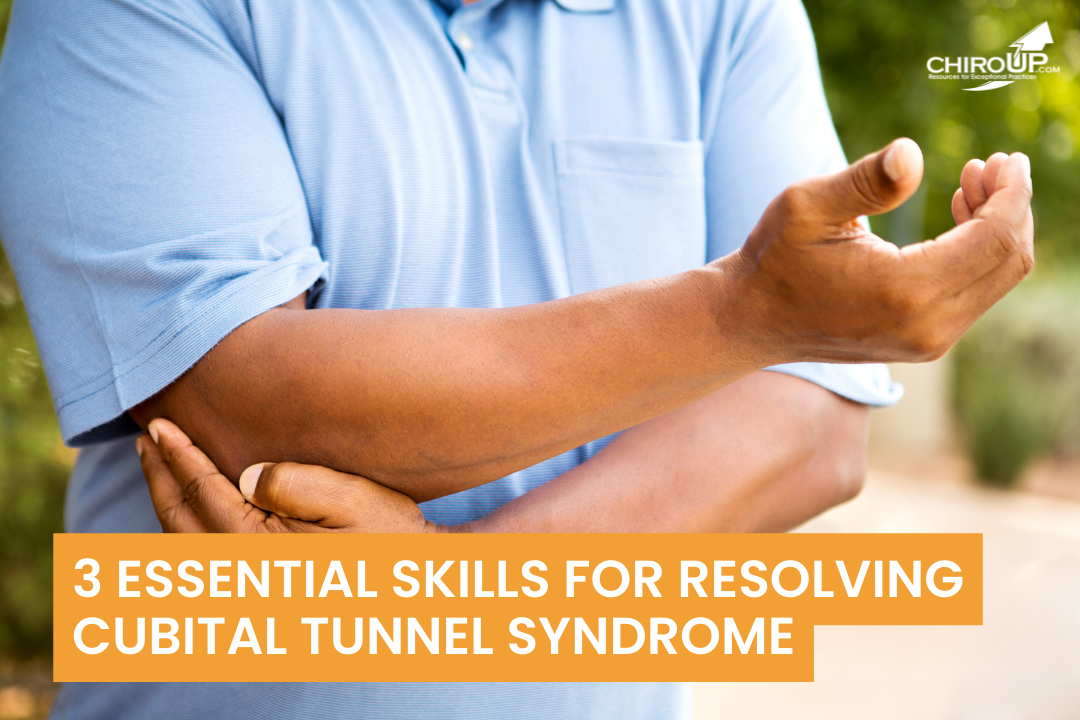Chiropractic Blog
ChiroUp’s weekly chiropractic blog contains clinical information needed to stay up-to-date on the latest chiropractic research.
Enter the following information to subscribe!
Looking for something specific? Search the blogs below.
Revolutionize Your Migraine Management: The Top 10 Chiropractic Tools of 2024
Emerging best-practice research never fails to teach us something new. And ChiroUp uses that data to keep your 150 management protocols up-to-date. In fact, in the past 24 months, your ChiroUp protocol for Migraine headaches has been updated nearly two dozen times with game-changing research regarding migraine and chiropractic. This blog will highlight our top 10 research-backed tools related to chiropractic treatment for migraines.
Top Overlooked Cause of Shoulder Pain
The relationship between chiropractors and shoulder pain is similar to the inseparable pairing of peanut butter and jelly. Our shoulders often bear the brunt of poor ergonomics and repetitive stress, a shared experience between chiropractors and their patients. While some patients engage in activities contributing to shoulder issues, most exhibit degeneration within the rotator cuff.
The Most Overlooked Cause of Neck Problems
New research has reaffirmed that weakness of one cervical muscle group is closely tied to chronic neck pain. This unit is also implicated as a provocative factor for cervical radiculopathy, cervicogenic headache, and cervicogenic vertigo. Do you know the answer? Check out this week’s blog and tutorial video to learn which muscle, plus specific strategies to test and strengthen it for quantifiably improved outcomes.
Top 10 Clinical Pearls to Differentiate Neurologic Arm Pain
Diagnosing neurogenic symptoms in the upper extremity can be daunting, even for seasoned clinicians. That's why ChiroUp is here to help! We've compiled our top ten tips to assist you in distinguishing between radiculopathy, peripheral neuropathy, double crush syndrome, and more. This week’s blog covers the essential orthopedic tests, neurodynamic screening maneuvers, and best practice treatments to successfully navigate the most common arm pain diagnoses. Don't miss this opportunity to enhance your diagnostic skills and gain clinical confidence.
Choi’s Test: Revolutionizing the Evaluation of Intervertebral Foramen
Discover another game-changer in manual medicine: Choi's Test, aka the Neck Tornado Test. Today’s blog will unveil a simple yet remarkably accurate means of evaluating nerve compression within the intervertebral foramen. “Choi's test is more sensitive with superior diagnostic accuracy for cervical radiculopathy diagnosed by magnetic resonance imaging than the Spurling test.” (1) Read the entire story behind this test, and access a video on how to perform this test on your next patient.
5 Potent Plantar Fasciitis Treatment Tools
Successful long-term management of cumulative trauma disorders requires more than just in-office treatment. So this week’s blog and video detail five evidence-based strategies to complement your potent hands-on care. In less than 5 minutes, you'll learn new skills to become the go-to doc for heel pain.
What Causes Hip Pain?
Great providers recognize patient-presentation patterns, allowing them to identify the proper diagnosis. Today's blog will provide the roadmap to identify the six most common conditions resulting in hip pain, including symptom location, aggravating factors, and clinical pearls to help you effectively manage these patients.
Benign Paroxysmal Positional Vertigo - BPPV
Benign paroxysmal positional vertigo (BPPV) is the most common cause of dizziness. Recently, a systematic review concluded that canalith repositioning maneuvers (aka Epley maneuver) should be the first line of care for BPPV since manual treatments have “superiority over medications [that…] have an uncertain effect.”
Check out this week’s blog to fine-tune your BPPV assessment and management skills with a quick tutorial on the best BPPV test and treatment maneuver. As a bonus, you can download our new Epley Maneuver PDF.
3 Essential Skills for Resolving Cubital Tunnel Syndrome
You’ve probably seen enough cases of carpal tunnel syndrome to recognize that it’s the most pervasive peripheral nerve entrapment in the upper extremity, but can you name the second most common? If you guessed Cubital Tunnel Syndrome, you’re correct. This week’s video blog will demonstrate the essential tools to solve this frequently overlooked runner-up that burdens up to 6% of the population. You’ll learn the top assessment, treatment, and nerve-flossing exercise for this condition in less than three minutes!
The All New Faber Test
Symptom response and symptom location during the FABER test provide vital clues as to the origin of tissue pathology within the hip. There are 3 primary symptom responses during this test.
#1: Increased Groin Pain
#2: Decreased Groin Pain
#3: Increased Posterior Buttock/Sacral Pain
Watch this video blog to see how one orthopedic evaluation can identify three different diagnoses based on symptoms.
Chiropractic Management of Compression Fractures
Effective and efficient chiropractors ask the right questions, allowing them to perform the most sensitive orthopedic testing to identify damaged tissue. Unfortunately, some pain generators within the spine are elusive to traditional orthopedic testing and history taking. This blog will dive deeply into one of the most common types of pain generators: vertebral fractures.
2 Exercises to End Iliotibial Band Syndrome
Increased activity and knee pain go together like peanut butter and jelly. The Iliotibial band is a frequent recipient of overuse stress. This blog will provide an updated etiology of the best practice management for Iliotibial Band Syndrome (ITBS), including a crucial rehabilitation strategy that every evidence-based chiropractor should consider.
3 Simple Tests for Identifying a SLAP Lesion
No single orthopedic maneuver reliably predicts a SLAP tear. However, research is filled with over two dozen tests to help establish this diagnosis. In this week’s blog, we’ll dive deeper into three of the most useful tests to help diagnose SLAP lesions and provide a couple of clinical pearls on patient management.
Plantar Fasciitis: Two Ways to Strengthen the Foot
Almost half of Plantar Fasciitis sufferers (45.6%) will continue to report symptoms ten years after onset. (1) These patients are not suffering from chronic inflammation (Plantar Fasciitis), instead, they have weakened and degenerated tissue (Plantar Fasciosis). Conservative treatment of plantar fasciitis, including manual therapy, stretching, myofascial release, orthotics, physical therapy modalities, and night splints may improve short-term symptoms for inflamed tissue. However, chronic Plantar Fasciosis (PF) often requires strengthening exercises for long-term results.
Can Chiropractors Use Cervical Epidural Steroid Injections?
While chiropractors cannot administer epidural steroid injections (ESI), we cannot turn a blind eye to a commonly used therapy. Sometimes our patients have already had an injection, while other times, we need to consider an ESI during our treatment plan for a patient that may benefit from its effects. Regardless of the timeline, valuable lessons from a patient’s response to this therapy may alter your care plan.
How Do You Rule Out the Cervical Spine as a Source of Arm Pain?
Do you ever perform orthopedic tests to RULE OUT a diagnosis? Most orthopedic and functional testing RULE IN a specific diagnosis. However, today's blog will uncover the secret to orthopedic testing that will save you time and your patient's frustration.
How Do You Measure For a Leg Length Discrepancy (LLD)?
Patients with gluteal tendinopathy, sacroiliac joint dysfunctions, knee, ankle, and back pain all may be in compensation to a LLD—especially in long-distance runners and walkers. If manipulation, rehabilitation, and manual therapy are not correcting the diagnoses mentioned above, consider looking for other abnormalities, like LLD, that could lead to biomechanical adaptations.
Lumbar Instability: Top Chiropractic Tests and Exercises
Is that symptomatic segment hypo-mobile or hyper-mobile? Providing a consistent and accurate answer to this question largely defines our clinical success.Estimates suggest that spinal segmental instability is responsible for between 13-33% of all LBP. Instability is synonymous with diagnoses like spondylolisthesis. However, a new study found that instability was also present in more than half (57%) of all discogenic LBP cases.You won’t want to miss this week’s blog for a from-the-trenches synopsis (and quick video tutorial) of the best-practice assessment and management of spinal instability.
Treating Runners with Gluteal Pain
Runners are often a pain in the butt—mainly because they have pain in their butt! This population of patients requires attention to detail so we can quickly get them back to the sport. Today’s blog will cover the differential diagnosis of the two most common extraarticular hip diagnoses affecting runners: Piriformis Syndrome (PS) and Ischiofemoral Impingement (IFI).
Assessing ACL Injuries with the Lever Sign
Use the chiropractic test the lever sign to manage and assess ACL injuries.




















